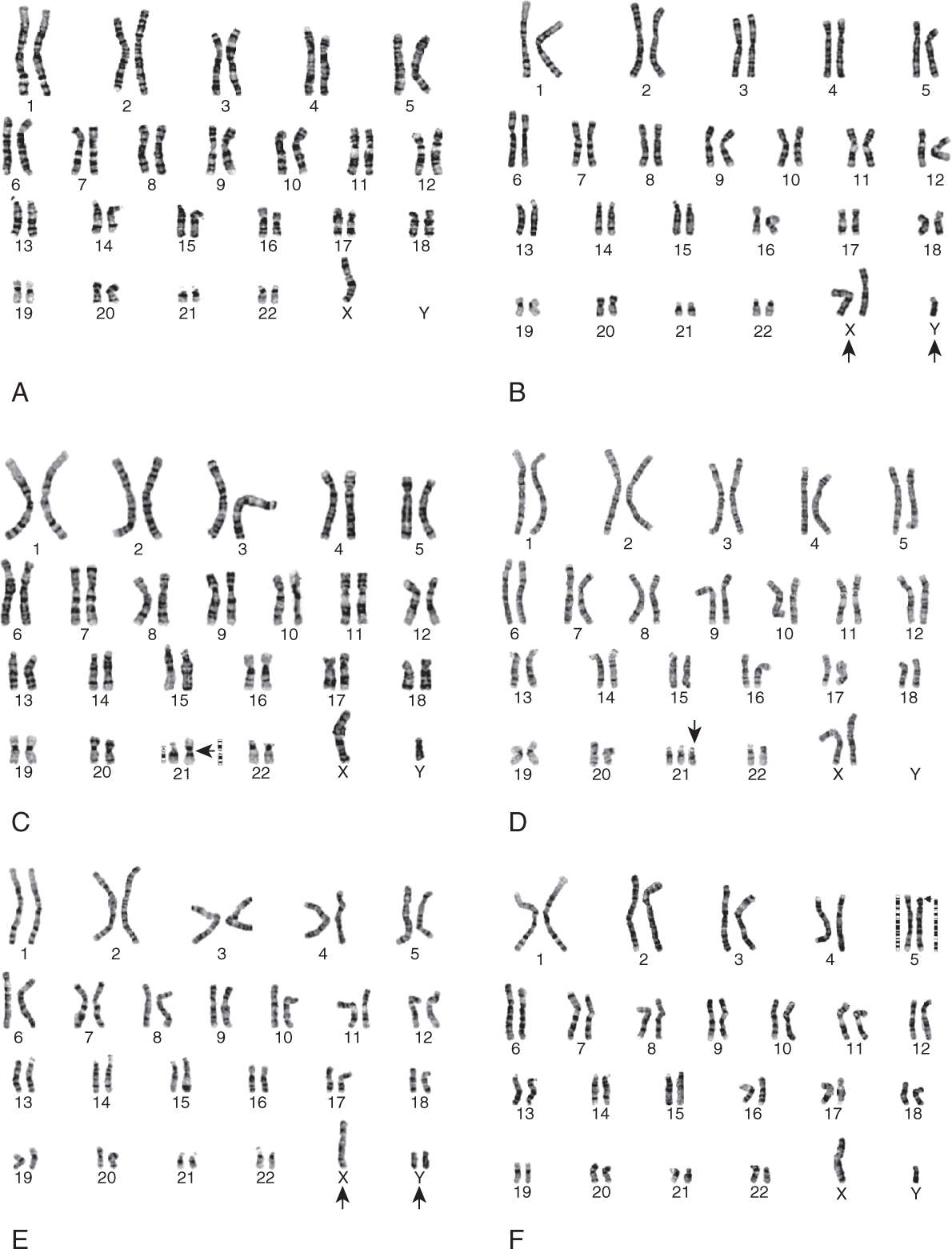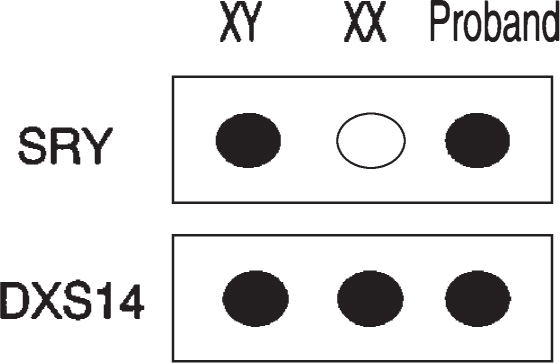470. Which of the diagrams above depicts a reciprocal translocation?
a. Diagram A
b. Diagram B
c. Diagram C
d. Diagram D
e. Diagram E
471. A 15-year-old Hispanic adolescent with manifestations of Turner syndrome is found to have a karyotype described as 46,XX,i(Xq). This best fits with which of the lettered diagrams above?
a. Diagram A
b. Diagram B
c. Diagram C
d. Diagram D
e. Diagram E
Questions 472 to 474
Refer to the figure below to answer the next three questions.

472. A 1-day-old newborn Caucasian girl has swelling of the dorsal areas of her feet in the nursery; later follow-up showed that the swelling resolved and she did well during childhood. She also has delayed menstruation, broad neck and chest, mild short stature, and decreased peripheral pulses that suggest the possibility of coarctation of the aorta. Ovaries could not be seen on pelvic ultrasound, and the uterus was thin. Her physician suspects a chromosomal disorder and orders a karyotype. Which of the results pictured is most likely?
a. Result A
b. Result B
c. Result C
d. Result D
e. Result F
473. A 1-day-old Caucasian boy feeds poorly, turning blue and choking after breast-feeding. He is also very floppy (hypotonic), has a loud heart murmur, and has some unusual physical findings. These include a flat occiput (brachycephaly), folds over the inner corners of the eyes (epicanthal folds), single creases on the palms (single palmar creases), and a broad space between the first and second toes. Significant in the family history is that one of the parents’ three prior children had Down syndrome. After obtaining a chromosome analysis, which of the results pictured is most likely?
a. Result A
b. Result B
c. Result C
d. Result D
e. Result F
474. A 2-week-old African American girl is hospitalized for inadequate feeding and poor growth. The parents are concerned by the child’s weak cry. An experienced grandmother accompanies them, saying she thought the cry sounded like a cat’s meow. The grandmother also states that the baby doesn’t look much like either parent. The physician orders a karyotype after noting a small head size (microcephaly) and subtle abnormalities of the face. Which of the results pictured is most likely?
a. Result A
b. Result B
c. Result C
d. Result D
e. Result F
475. A family is seen for routine prenatal counseling because the mother of two normal children is of age 35, the arbitrary “advanced maternal age” when the approximate 1 in 100 risk for fetal chromosome disorders is deemed significant. Family history reveals that the mother’s parents and her husband all have had onset of high blood pressure (hypertension) at early ages, and two of mother’s grandparents died of strokes that may be hypertension related. The mother also had some hypertension in the third trimester of her last pregnancy. Recognizing that hypertension is a multifactorial trait, which of the following is the most appropriate explanation and counseling for the couple?
a. Multifactorial determination indicates an interaction between the environment and a single gene, implying a 50% risk for eventual hypertension in the mother and the offspring.
b. Multifactorial determination indicates an interaction between the environment and multiple genes, implying a 5% to 10% risk for eventual hypertension in the mother and the offspring.
c. Multifactorial determination results from multiple postnatal environmental factors, implying a 75% to 100% risk for eventual hypertension in the mother and a 5% to 10% risk to the offspring.
d. Multifactorial determination results from multiple pre- and postnatal environmental factors, implying a 75% to 100% risk for eventual hypertension in the mother and a 5% to 10% risk to the offspring.
e. Multifactorial determination implies action of multiple genes independent of environmental factors, implying low risks for hypertension in the mother’s next pregnancy, but a 5% to 10% risk for eventual hypertension in offspring.
476. The incidence of a genetic form of diabetes insipidus (MIM*304800) in North Americans was hypothesized to be related to immigration of affected individuals on the ship Hopewell that arrived in Halifax, Nova Scotia several hundred years ago. If the disease allele were known as A, and residents near Halifax had 10 times the frequency of this allele as did those on mainland Canada, which of the following terms best describes this phenomenon?
a. Selection for allele A
b. Linkage disequilibrium with allele A
c. Linkage to allele A
d. Founder effect for allele A
e. Assortative mating for allele A
477. Polycystic kidney disease (MIM*173900) is a significant cause of renal failure that presents from early infancy to adulthood. Early-onset cases tend to affect one family member or siblings, whereas adult-onset cases often show a vertical pattern in the pedigree. Which of the following offers the best explanation of these facts?
a. Pleiotropy
b. Allelic heterogeneity
c. Locus heterogeneity
d. Multifactorial determination
e. Variable expressivity
478. Every prenatal diagnostic evaluation should include which of the following procedures?
a. Level I ultrasound
b. Chorionic villus sampling (CVS)
c. Doppler analysis
d. Amniocentesis
e. Genetic counseling
479. DNA analysis is performed on a family because the first child has propionic acidemia. The parents desire prenatal diagnosis, and the fetal DNA is also analyzed for polymorphic alleles A and B that are linked to the causative mutation (see the figure below). The results are shown below. Which of the following risk figures reflect the risk of the fetus being affected before and after testing?

a. ½, virtually 0
b. ¼, 2/3
c. ¼, ½
d. ¼, 2/3
e. ¼, virtually 0
480. A newborn presents with ambiguous genitalia, having an enlarged clitoris or small phallus and labial fusion or hypoplastic scrotum. The newborn’s sex can most reliably be established by which of the following?
a. Buccal smear to determine if there are one or two Barr bodies
b. Buccal smear to determine if there is one Barr body or none
c. Peripheral blood karyotype
d. Bone marrow karyotype
e. Polymerase chain reaction (PCR) using primers specific for the long arm of the Y chromosome
481. The dot-blot shown below examines DNA from a child with ambiguous genitalia after polymerase chain reaction (PCR) amplification and hybridization with DNA probes from the X and Y chromosome. In this case, the Y chromosome probe (DXS14) is from the SRY region of Yp that contains the male-determining region. DNA from control male and female patients is also applied to the dot-blot. Based on the dot-blot results, which is the most likely conclusion?

a. The proband is a genetic male.
b. The proband is a genetic female.
c. The proband is male.
d. The proband is female.
e. The proband is mosaic 46,XX/46,XY.
Urogenital System—Urology, Gynecology, and Nephrology
Answers
457. The answer is e. (Murray, pp 371-375. Scriver, pp 5587-5628. Lewis, pp 232-236.) The normal parents having two hypopigmented children would fit the usual inheritance mechanism for oculocutaneous albinism (MIM*203100), an autosomal recessive disorder implying a one in four or 25% risk for their newborn to be affected with albinism (answer e, not a or b suggesting a one in eight risk). Decreased melanin synthesis in albinism increases the exposure of DNA in skin cells to ultraviolet rays from sunlight and leads to DNA cross-linkage (excluding answers c and d). Cross-linking occurs through the formation of thymine-thymine dimers. The DNA crosslinks cause higher rates of mutation and skin cancer in albinism, mandating the wearing of protective clothing, sunglasses, and sunscreens by affected individuals. DNA deletions and point mutations are less common than DNA cross-links after sunlight exposure.
458. The answer is c. (Murray, pp 11-14. Scriver, pp 3-45. Lewis, pp 188-194.) The amino acid cystine, essentially a dimer of cysteine, accumulates in the lysosomes of patients with cystinosis (MIM*219800). It has a sulfhydryl side group with a pKa of 8.3 that is different from the amino side groups of lysine, arginine, and glutamine (pKas 9-12). These patients exhibit progressive vision problems and renal failure, but these problems can be forestalled by cysteamine treatment, which complexes with cystine and allows egress from lysosomes.
459. The answer is b. (Murray, pp 84-93.) Ligand-receptor and substrateenzyme reactions are both saturable processes with similar dependence of reaction rate on ligand/substrate and receptor/substrate concentrations. Competitive inhibitors function by resembling the substrate, binding to the active site without undergoing catalysis or transport, and thereby blocking access to the substrate (incorrect answers a, c-e). Thus, the structures of competitive inhibitors tend to resemble the structures of the substrate and are often called substrate or ligand analogs. The effects of competitive inhibitors can be overcome by raising the concentration of the substrate, and Lineweaver-Burk plots like those in Fig. 4 of the High-Yield Facts can distinguish competitive inhibitors that can be overcome to yield the same Vmax (different Km for substrate when inhibitor is present) from noncompetitive inhibitors that act outside the substrate-binding site (same substrate Km but lower Vmax in the presence of inhibitor).
460. The answer is b. (Murray, pp 282-296, 498-516
Stay updated, free articles. Join our Telegram channel

Full access? Get Clinical Tree


